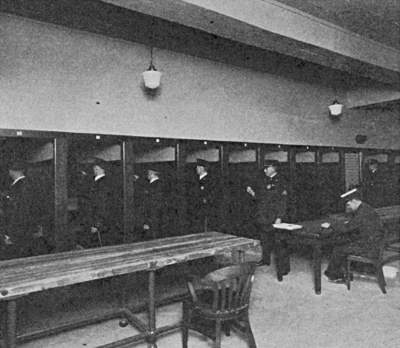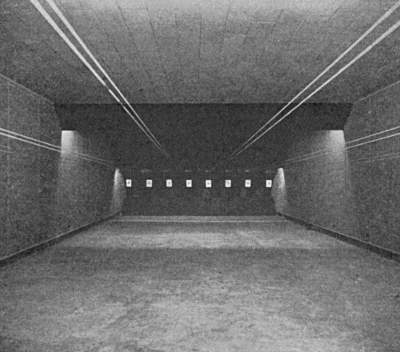The following information on the revolver club comes from Section 19 of Shooting by J. Henry FitzGerald. Shooting is also available to purchase in print.
A revolver club is usually started by two or three men who are shooting enthusiasts and who wish to get their friends interested in the sport. They realize, of course, if they start a small shooting club it means larger quarters and better equipment. It means competition and a larger circle of friends.
A very prosperous revolver club may be started with twenty-five members and if one of the twenty-five owns a large cellar or garret it helps to lower the range expenses. If necessary fifty members can be induced to belong to the revolver club and this is enough to cover the expenses of a good revolver range, the cost of dues being governed by the expense of procuring a suitable range.
If twenty-five members are planned for, then at least three targets should be available. If fifty members are planned for, six targets should be installed. This would mean a room about twelve feet wide and seventy-five feet long for three targets, and about twenty-two feet wide and seventy-five feet long for six targets. If rifle shooting is to be part of the club with a twenty-five yard range, then at least eighty-five feet will be needed to allow for backstop firing point, prone benches, etc.
A lounging room really is necessary in every range, otherwise the conversation and noise will interfere with the shooters. If the lounging room is to be behind the firing point, then the range will need to be more than seventy-five feet long, or, if it is to be on the side, then that much space must be added to the width of the range.
With a suitable range location in sight, the first step is to call a meeting of every one in the locality who would possibly be interested in pistol and revolver shooting. It is easy to secure the use of a hall, lodge room or possibly the armory for the first meeting. Then, through the founders of the revolver club or some one imported for the occasion, sell to those present the idea of a pistol and revolver club for get-together shooting. Banks, sporting goods stores, and, in fact, every company or organization that has money or property to protect, should become interested in the proposition, and by all means the police should be invited to join the shooting club. Interest local newspapers in the work. They can, and will, gladly help and will reach people who otherwise might never become interested.
While the audience is in a receptive mood it is well to collect the names of those who wish to become members. Many of them who have no intention of shooting, will join to help the cause along and often become enthusiastic members.
The case should be stated clearly: the range site in view, the expense of installing fixtures, rent, the number of targets planned for, the number of members planned for, dues based on that number, and the fact that the revolver club will be incorporated. It is best to have two range sites and two lists of range equipment ready, then submit both, allowing the prospective members to vote on them. It is better to start a shooting club on a small scale than never to start at all.
The range income is derived from dues, sale of targets, income from matches and sale of lead and shells. If lockers are purchased or built they will net a substantial revenue. Novelty matches will also meet with approval and bring in revenue.
One popular source of revenue would be club medals. They are: Marksman, Sharpshooter, and Expert. For example: ten scores of seventy-five or better may be exchanged for a Marksman’s Medal. Ten scores of eighty-five or better may be exchanged for a Sharpshooter’s Medal, and ten scores of ninety-two or better for Expert Medal. Targets should be witnessed by an officer of the revolver club and the medals may be made of bronze for Marksman, bronze and silver for Sharpshooter, and silver for Expert. A gold medal may be given for ten scores of ninety-five or better. These medals may be purchased at a price that will, at ten cents per target, give the revolver club a fair profit.
It will be necessary to elect officers for the revolver club. A president, vice-president, secretary, treasurer, and shooting master are the usual ones. It is well to have a board of directors of which the officers are members.
When the club has reached the stage of incorporation a set of by-laws should be adopted and a club name decided upon. The N.R.A. By-Laws may be adopted or changed to suit the requirements of the club.
I may here cite what I consider the record in forming a revolver club. I arrived in Muncie, Indiana, on a night that police and citizens were to form a revolver club. The city officials were deeply interested, especially the chief of police. The prime factor in this project was Mr. Harry C. Almy, vice-president and treasurer of the Delaware County National Bank. In less than twenty-four hours a club was started with one hundred and forty-five members enrolled. They now have indoor and outdoor ranges and the club is still growing. Mr. Almy is one of the best informed men on target and protective shooting in the country and if his ideas were followed we would have flourishing revolver clubs in every city and town.
As in all other clubs and gatherings it rests with the officials of the club whether it will be a success or not. A pleasant word, a little encouragement here and there, will always help make new members and visitors feel at home. In one revolver club of which I was a member for some years, the officers voted to appoint a reception committee to entertain visitors and new members. I made a motion that every member of the club be appointed on that committee, and I think the scheme was a success.
Fancy equipment in the revolver club will not make the members better shots. Inexpensive equipment and plenty of practice will give better results.
Saint Louis Indoor Police Range
The new indoor range used by Saint Louis Police Department is one of the finest in the United States. In addition to the eight firing points it has two moving targets. They are placed in position at the firing point and as wheel is turned they travel along the left-hand wall to the target line; they may then be moved across the target line at any speed desired (about twenty-four feet) and to a horizontal position against right wall of the range. This is excellent practice for the police or any one who wishes to hit moving objects as targets. The carriers hold two targets and may be moved in either direction at will.

The twenty-yard target used is divided by fine lines into twelve sections, each line extending from center of target to the position of the figures on the face of a clock, and are so numbered. This is an aid to the contestants, as they can then see clearly whether the arm is grouping to right or left, high or low. It is true that one can do this on any target, but it is brought more clearly to the shooter’s attention if the lines are used.

The design, material, and workmanship of this range are a credit to any city as are also the classrooms and offices. An up-to-date loading department is also installed and this modern equipment, in connection with last word in police training by Lieutenant Nick Bausch and his assistants, will perfect policemen in the performance of their duty in a few weeks and impart information to them that would take them years of actual police duty to acquire.
